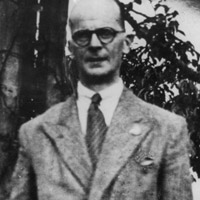In 2005 the FBI published a guide to serial murder for investigators which listed seven myths or misconceptions about serial killers. Their examples were all cases from the United States – so we decided to try and match the myths with cases from London’s own history of murder.
1) Myth: Serial killers are all dysfunctional loners.
Many serial killers hide in plain sight within their communities. Serial murderers often have families and homes, are gainfully employed, and appear to be normal members of the community.
FBI
Although George Joseph Smith did not have a regular job he was far from a loner – he actively sought out women to seduce, marry and then steal from. At least seven women fell prey to his charms. Three of them were murdered.
2) Myth: Serial killers are all white males.
Contrary to popular belief, serial killers span all racial groups.
FBI
3) Myth: Serial killers are only motivated by sex.
All serial murders are not sexually-based. There are many other motivations for serial murders including anger, thrill, financial gain, and attention seeking.
FBI
Peter Bryan busts both these myths. He was born in London but his parents were immigrants from Barbados. And by the time he was arrested for his second murder he had developed an appetite not for sex, but for human flesh.
4) Myth: All serial murderers travel.
Most serial killers have very defined geographic areas of operation. They conduct their killings within comfort zones that are often defined by an anchor point (e.g. place of residence, employment, or residence of a relative). Serial murderers will, at times, spiral their activities outside of their comfort zone, when their confidence has grown through experience or to avoid detection.
FBI
Although a number of London murderers have carried out their crimes across the country (see the case of George Joseph Smith above), one of the most famous examples is John Reginald Christie, who killed at least six women at his home in Rillington Place in Notting Hill. See also Dennis Nilsen, who killed at least 15 teenage boys and men at his homes in Cricklewood and Notting Hill.
5) Myth: Serial killers cannot stop killing.
It has been widely believed that once serial killers start killing, they cannot stop. There are, however, some serial killers who stop murdering altogether before being caught. In these instances, there are events or circumstances in offenders’ lives that inhibit them from pursuing more victims. These can include increased participation in family activities, sexual substitution, and other diversions.
FBI
The world’s most famous serial killer operated in a very small area of east London and was never caught – ‘Jack the Ripper’. The killings ceased in November 1888, three months after they began. Did ‘Jack’ die or leave the country, or did he simply just stop killing?
6) Myth: All Serial killers are insane or are evil geniuses.
The media has created a number of fictional serial killer “geniuses”, who outsmart law enforcement at every turn. Like other populations, however, serial killers range in intelligence from borderline to above average levels.
FBI
The ‘Finchley baby farmers’ Amelia Sach and Annie Walters were neither intelligent nor insane but are thought to have murdered dozens of babies in the early years of the 20th Century.
7) Myth: Serial killers want to get caught.
While most serial killers plan their offenses more thoroughly than other criminals, the learning curve is still very steep. They must select, target, approach, control, and dispose of their victims. As serial killers continue to offend without being captured, they can become empowered, feeling they will never be identified. It is not that serial killers want to get caught; they feel that they can’t get caught.
FBI
If serial killers really wanted to be caught then surely we would know the identity of the killer the media dubbed ‘Jack the Stripper‘. Between 1964 and 1965 at least six women were killed and their nude bodies left around London or dumped in the River Thames.


Is the Jack The Stripper case truly unsoved? I believe the investigating officers at the time were certain that a security guard working in the Park Royal or Acton area who committed suicide was the culprit but never released details of the man’s identity.
You’re right that the lead detective identified a guy called Mungo Ireland (see http://en.wikipedia.org/wiki/Jack_the_Stripper). But it’s generally regarded as an unsolved case and there have been several other suspects identified since in a number of books and TV programmes. Unfortunately the police files on the case are closed until 2050… (http://www.nationalarchives.gov.uk/catalogue/displaycataloguedetails.asp?CATLN=6&CATID=7988754&j=1)